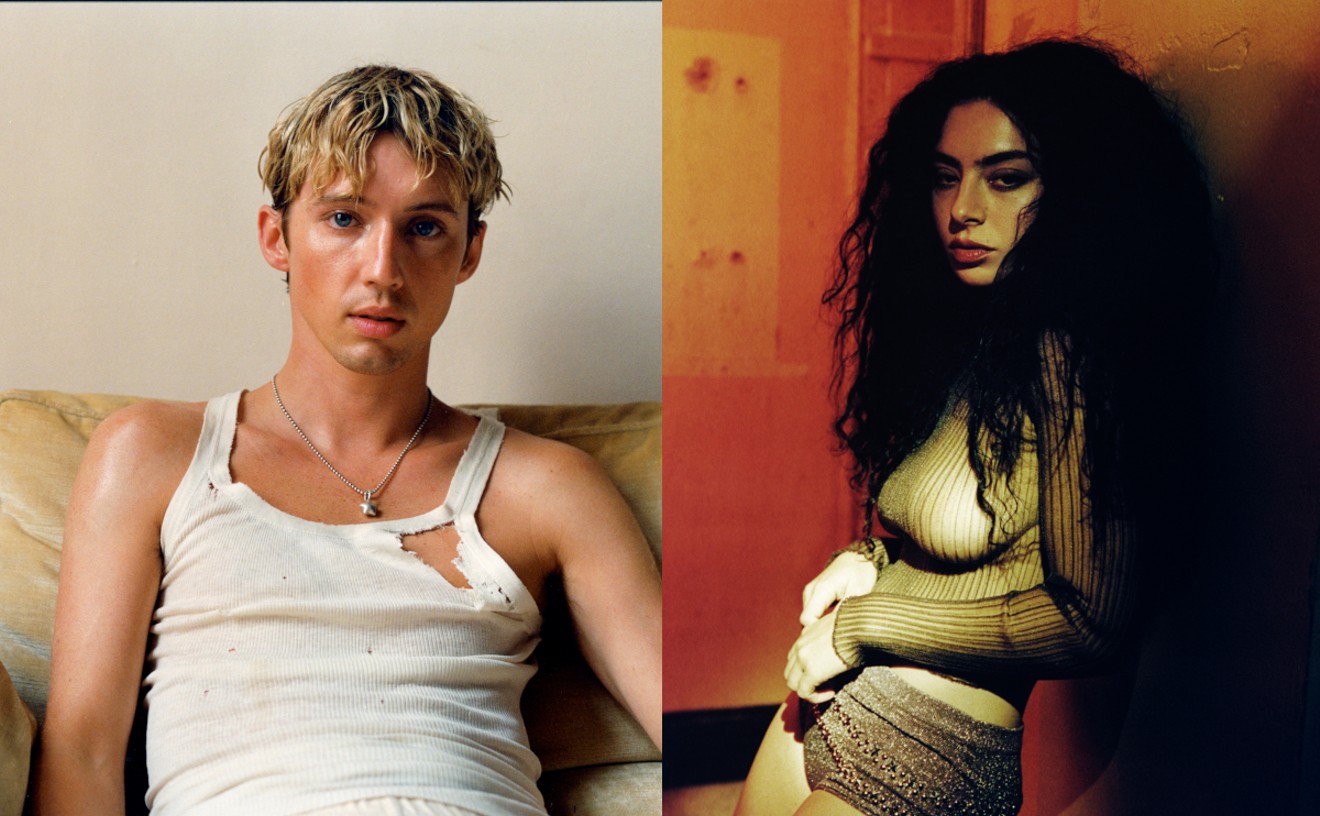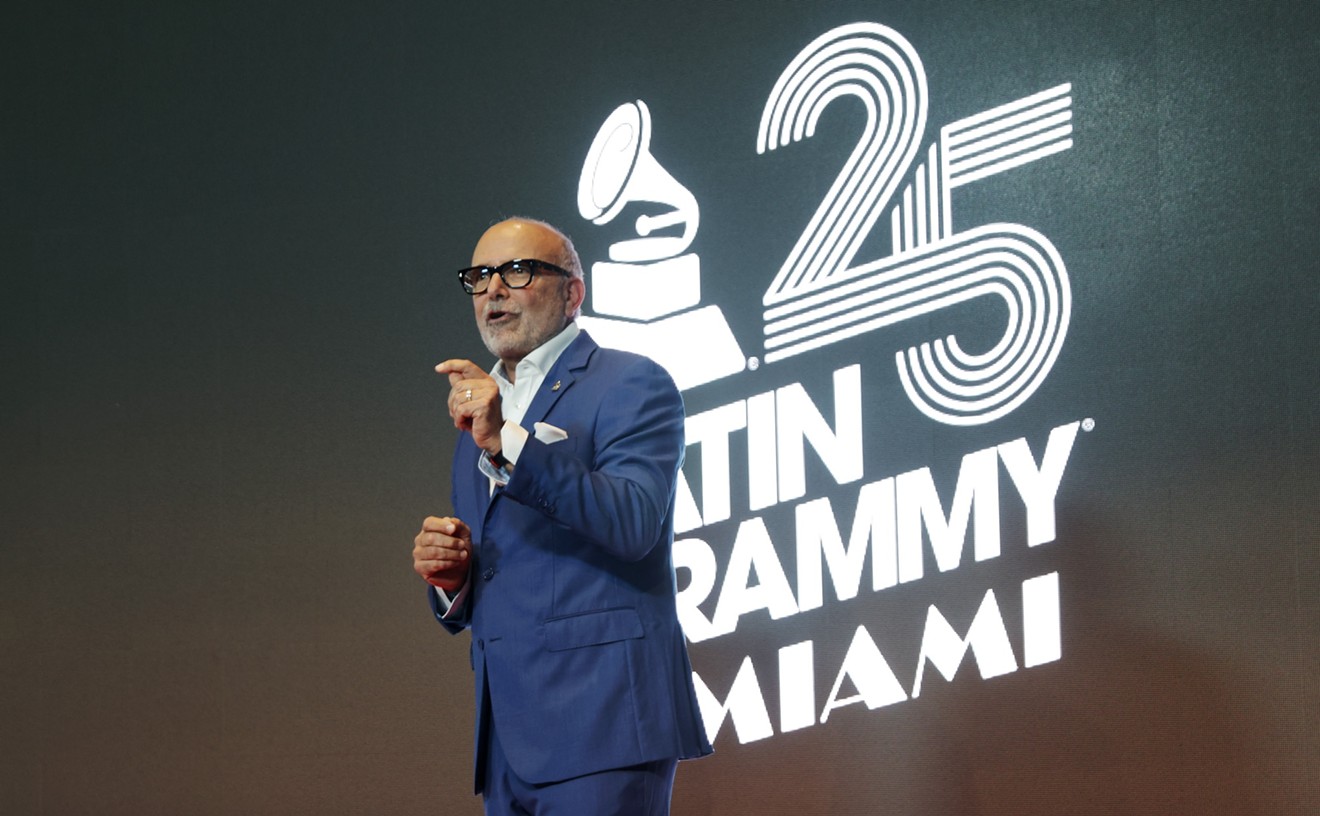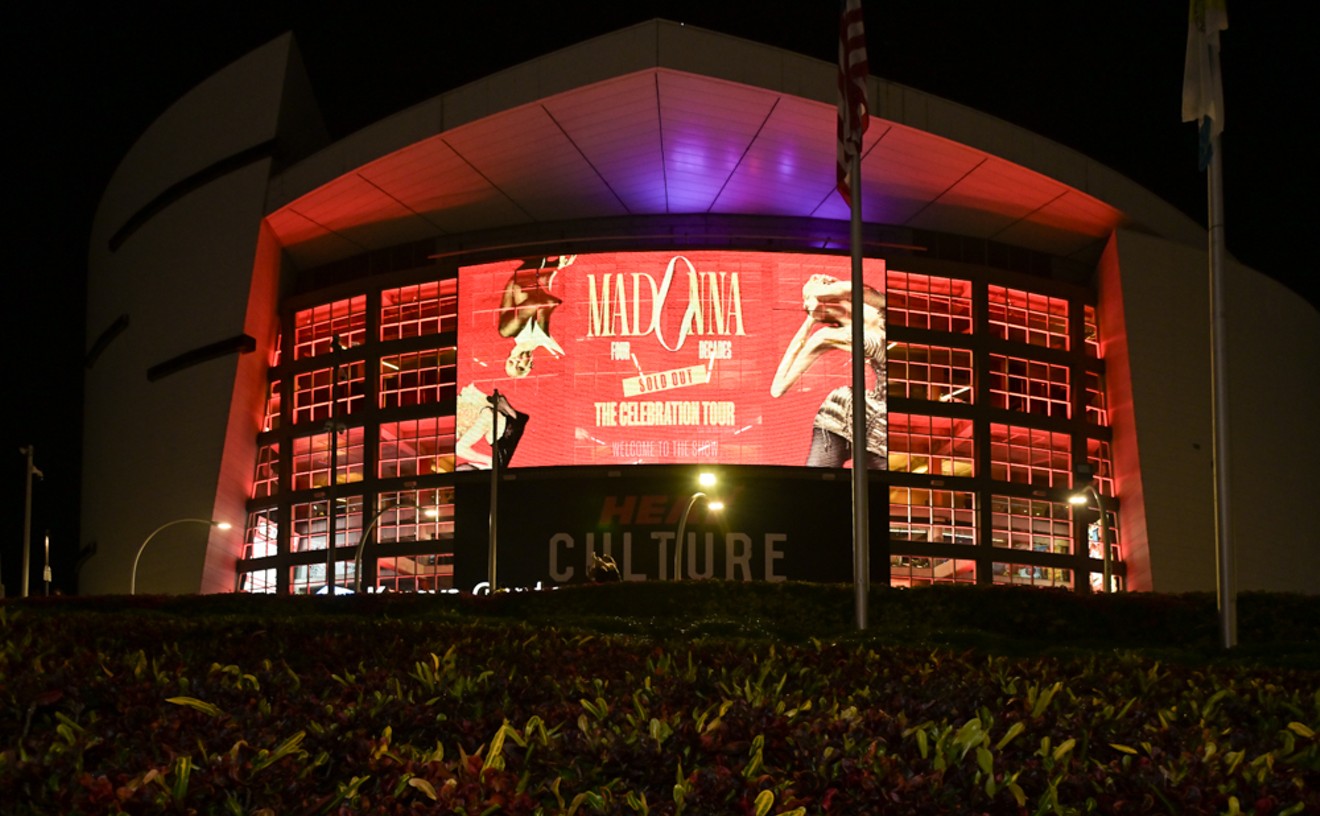This will garner one of two reactions: You're either doing back flips toward your computer to order your own box or you're scratching your head, wondering who the hell could sit through take after take of the same seven songs (eight, if you count the newly discovered "Lost in the Future," which ain't exactly a gem, and was rightfully discarded before the original record was completed). The truth is this fly-on-the-wall-style documentary keeps on working for eight hours primarily because of the way the record was made in the first place.
"The interesting thing about this project is it was obviously an attempt for the band to record their stage show at the time," says Bill Inglot, Rhino's project producer and the guy who researches and finds the original tapes before restoring, mixing, and mastering them as needed. "The first record they did for Elektra [The Stooges] was certainly a more formal recording per se. It was produced by [former Velvet Underground member] John Cale and seemed a bit more tracked. Which means they cut a track with all the instruments, and then they added Iggy's vocals, added tambourine, added whatever was needed. The first record's a little bit more produced."
The decision to record Fun House live in the studio came from producer Don Gallucci. As a result of this method, you don't hear the tedious one-overdub-at-a-time layering that constitutes the making of most modern recordings. (Ever sit through director Jean-Luc Godard's torturous documentary of the Stones laboring over "Sympathy for the Devil"?) Instead each take on Fun House was already complete, with lead vocals, guitars, drums, and sax solos all recorded at the same time. Which means the listener gets to hear a real rock band with an actual vision passionately cranking it out raw over and over again. In an age where a series of alternative rock groups mope on and off the charts with one hit, and pop singers apparently come from a generic stamp press to exist in a media netherworld that lies somewhere between Britney Spears's allegedly fake breasts and Jennifer Lopez's heavily insured ass, this kind of honest-to-goodness gettin' down just doesn't happen anymore.
"So few rock records exist in this kind of time and space continuum," agrees Inglot. "Fun House was done more like a 1958 jazz album. Musicians go in, they play, they find something they like, and then they go home. Certainly once you get past 1970, I don't know that anybody ever really attempted that sort of thing again."
"We were totally prepared because [producer] Gallucci wanted to capture the live show," remembers Stooges guitarist Ron Asheton. "That was the cool thing. We just set up in the studio and did our live show. There were really no overdubs. I maybe went back after I did my leads with the three-piece and added a little bit of rhythm guitar stuff here and there. But mostly everything was live."
By the summer of 1970, Gallucci had scored a hit with his first production for Elektra: Crabby Appleton's "Go Back" single. His decision to record the Stooges live came after his boss Jac Holzman flew him to New York to see the band perform. "They were playing in some little club. Someone announces over the PA: 'And here they are, Iggy and the Stooges!'" recalls Gallucci, who left the music business shortly after his work on Fun House for pursuits in real estate. "This terminally skinny guy comes out dancing and writhing in front of this loud three-piece band, and he's wearing nothing but Levi's, boots, and evening-length silver lamé gloves. That's it. I think maybe he had a dog collar around his neck. He immediately starts jumping up on tables and grabs the fishnet candle lamps, pouring hot wax all down his chest. Jac asks me the next day: 'What do you think?' I said, 'Well, it's a real interesting act, but I don't think you can get this feeling on tape. It's definitely a performance kind of situation.' Jac responded, 'Well, I really believe in them. I'm flying them out to the West Coast, and you'll record them.'"
Gallucci decided the only way to put that kind of power and ferocity to tape was simply to turn the Stooges loose in the studio. He was certainly no stranger to recording this way. In fact his career began almost by accident when as a precocious fifteen-year-old in 1963, he played electric piano on the Kingsmen's hit version of "Louie Louie." At that time recording live to mono was still a common practice. To tackle the issue of recording the Stooges this way, however, his first order of business was to transform Holzman's newest pride and joy -- a Hollywood-based recording studio on La Cienega Avenue -- into a place where the band could be accurately captured. Not exactly the easiest thing, since before Elektra hit the pop charts with Love and the Doors, they were primarily a folk-music label, and Holzman built his studio with simple acoustic guitar and vocals in mind.
"Jac had one of the first transistor board studios on the West Coast, and he worked diligently to get rid of any room sound," continues Gallucci. "The studio itself had infinite soundproof baffling: all kinds of movable panels, wavy walls, all the latest technology in that day to get perfectly clean, crisp recordings. He was also one of the first people to push Dolby, so he could get this great voice and guitar stuff. So now we're in this superclean studio that is the total antithesis of how you'd want to record the Stooges. There's no edge to it. There's no grunge. There's no warmth of the old tube amps. So we basically just ended up tearing the studio down. We took out all the baffles, all the carpets. We did everything we could to make it a live environment. And then we broke all the rules. We didn't even baffle or separate them from each other. We just put mikes in front of their amps, and Iggy sang live with a hand-held mike. All of this muddied the sound and made it sound more live, even though you could still listen to it and think, Gee, it still sounds sorta clean." The fact that Iggy sang through a PA system in the studio created some of the first purposely distorted vocals on record, King Crimson notwithstanding. Says Asheton: "I think Jim [Osterberg, a.k.a. Iggy] was smart. He set up a little PA that was just like the rest of the amplifiers, 'cause he wanted to be right there with the band. He liked that PA sound. We never even questioned it. Well, cool, he's gonna do it live. We're not gonna do the old, sterile trip after all."
On Fun House the Stooges took their song structures to even more basic levels than on their debut, and then stretched them as though they were elastic. Simple, machinelike (but never mechanical) riffs changed slightly from verse to chorus, then into open solo sections, all cued by Iggy's vocals. On the title track, the more tenor saxophonist Steve Mackey takes off, the more Iggy encourages him, yelling "Blooowww!" all the while. Then, just as suddenly, he reels the guys back in: "Hey, bring it down! Let me in!" This is not at all unlike how James Brown was leading his own band at the same time. Asheton reckons it's a fair comparison.
"We'd always start practices with a jam," says the guitarist. "[Bassist] Dave [Alexander] would say, 'Hey, I've got this bass line.' He'd play it, and then we just built around it. We all liked James Brown, so we just jammed on that in that same way. We just kind of whipped it together, a meeting of the minds. And Iggy was always a good arranger."
The heavy funk of the title track was complemented by the hard-rock jamathon of "1970," which found Mackey heading into free-jazz territory. Originally a sax player for a school marching band and later a rock combo, Mackey recalls being introduced to more adventurous playing by the MC5's notorious manager, John Sinclair. "He turned me on to a lot of stuff like that: Archie Shepp, Coltrane, everything." Soon Mackey was adding the same free elements to his own Detroit-based group, Carnal Kitchen. "We had adopted that pretty much early on. Iggy heard us play our first gig in '69 sometime. He came up to me one day and just says, 'We're gonna jam on Thursday night. You wanna come by and jam with us?' I'd been out to the Stooges' house before, so I drove out there on Thursday night, and he pretty much already had Fun House figured out and how he wanted it to sound."
"We really wanted to do something completely different," confirms guitarist Ron Asheton. "All our early stuff was totally freeform. We loved Coltrane. And being limited as musicians on our instruments, we'd often just go to the show basically unprepared. 'Okay, here's the riff. We'll just work off that riff and see what happens and where it goes.' That's how we built stuff up. Even when we were signed to Elektra, we didn't really have tunes per se."
The Stooges' set at the time would always end with "Fun House," which would traditionally dissolve into improvisatory madness to close the show. On the record, however, this exploratory part was turned into its own separate piece called "L.A. Blues." (On the box set, the unedited seventeen-minute version is titled "Freak.") The decision to break the bit into two distinct numbers again came from Gallucci.
"He thought it would be a good idea, and he was the producer, so nobody argued with him about it," says Mackey, who later went on to play with Andre Williams, the Violent Femmes, and Snakefinger. "We just said, 'Okay, that's cool.' But it was really interesting trying to get that energy coming cold out of nowhere. That particular session [for 'L.A. Blues'] was pretty far-out. I guess I decided I was going to be psychedelic for that session. And so I was, chemically, if you know what I mean. I don't know if anyone else in the studio was, but I certainly was."
Asheton -- who's still a working musician as well as a screenwriter and film actor (you have seen Mosquito, right?) back home in Detroit -- is now able to put his little ol' Michigan garage band into proper perspective. "We never wanted to be any kind of pop band. We really wanted to be something different. And because we started out as musical virgins, we got to develop and create something that was fresh. I think it was really to our benefit that we didn't know how to play our instruments real well. It turned out to be the genesis of a whole new sound."
It will forever be argued among the faithful whether the pinnacle of that sound was Fun House or the more standard hard rock (by Stooge standards, that is) of their third album, Raw Power, which was produced by David Bowie and released three years later on Columbia. To Rhino's credit they're aware that there are just enough Fun House addicts out there to make an undertaking such as this worthwhile. Says David Baker of Rhino Handmade: "I think it's now generally acknowledged that Fun House was a primordial record. It invented an entire genre of music years before that genre became popular. It's now an American classic."
"It's funny. I eventually grew to love it because I loved their rawness," says Gallucci. "There were no apologies in the music. But it wasn't just simple music; it was almost Zenlike. They had pared everything down, not because they were necessarily bad musicians or because they were dumb. They actually got rid of all the fey stuff that started to pop up in rock right about then. They eliminated all the artsy stuff and went back to just pure to the bone, to the studs, rock. At the same time, I knew that nobody would get it in 1970. But pioneers always get the arrows and slings. Eventually they were recognized, and I think that's great. But back in 1970, they were on a mission."
Asheton can actually laugh about it now. "The Stooges were always kind of looked down upon. 'Bunch of freaks! They can't play!' So ha, ha, ha! We were freaks back then. Now we're the godfathers of this type of music."










